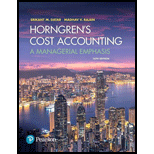
Make or buy, unknown level of volume. (A. Atkinson, adapted) Denver Engineering manufactures small engines that it sells to manufacturers who install them in products such as lawn mowers. The company currently manufactures all the parts used in these engines but is considering a proposal from an external supplier who wishes to supply the starter assemblies used in these engines.
The starter assemblies are currently manufactured in Division 3 of Denver Engineering. The costs relating to the starter assemblies for the past 12 months were as follows:
| Direct materials | $ 400,000 |
| Variable direct manufacturing labor | 300,000 |
| Manufacturing |
800,000 |
| Total | $1,500,000 |
Over the past year, Division 3 manufactured 150,000 starter assemblies. The average cost for each starter assembly is $10 ($1,500,000 ÷ 150,000).
Further analysis of manufacturing overhead revealed the following information. Of the total manufacturing overhead, only 25% is considered variable. Of the fixed portion, $300,000 is an allocation of general overhead that will remain unchanged for the company as a whole if production of the starter assemblies is discontinued. A further $200,000 of the fixed overhead is avoidable if production of the starter assemblies is discontinued. The balance of the current fixed overhead, $100,000, is the division manager’s salary. If Denver Engineering discontinues production of the starter assemblies, the manager of Division 3 will be transferred to Division 2 at the same salary. This move will allow the company to save the $80,000 salary that would otherwise be paid to attract an outsider to this position.
- 1. Tutwiler Electronics, a reliable supplier, has offered to supply starter-assembly units at $8 per unit. Because this price is less than the current average cost of $10 per unit, the vice president of manufacturing is eager to accept this offer. On the basis of financial considerations alone, should Denver Engineering accept the outside offer? Show your calculations. (Hint: Production output in the coming year may be different from production output in the past year.)
- 2. How, if at all, would your response to requirement 1 change if the company could use the vacated plant space for storage and, in so doing, avoid $100,000 of outside storage charges currently incurred? Why is this information relevant or irrelevant?
Want to see the full answer?
Check out a sample textbook solution
Chapter 11 Solutions
Horngren's Cost Accounting: A Managerial Emphasis (16th Edition)
- ayco Inc. started its operations in 2022. Its sales during 2022, all on account, totalled $700,000. The company collected $500,000 in cash from customers during the year and wrote off $8,000 in uncollectible accounts. The company set up an allowance for doubtful accounts at December 31, 2022, its fiscal year-end, and determined the account balance to be $14,000. The unadjusted balances of selected accounts at December 31, 2023 are as follows: Accounts receivable $ 300,000 Allowance for doubtful accounts (debit) 10,000 Sales revenue (including 80 percent in sales on account) 800,000 Aging of the accounts receivable on December 31, 2023, resulted in an estimate of $11,000 in potentially uncollectible accounts. Required: 1. Prepare the journal entries to record all the transactions during 2022 and post them to appropriate T-accounts. (If no entry is required for a transaction/event, select "No journal entry required" in the first account field.)…arrow_forwardCalculate the sample size based on the specifications in Buhi's contract. Make sure it is within budget, reasonable to obtain, and that you use appropriate inputs relative to market research best practices. Use the calculator to adjust the sample size statement. Use the agreed-upon sample size in Buhi's contract: 996. In your secondary research, find the target population size (an estimate of those in the United States looking to purchase luggage in the category in the next two years). You will use this target population size for each sample size estimate. Adjust the provided sample size calculator inputs to find the rest of the figures that get you to the agreed-upon sample size. The caveats from Buhi are that you must: Use the market research standard for your confidence level. Use a confidence interval that is better than the market research standard for your confidence interval.arrow_forwardThe partnership of Keenan and Kludlow paid the following wages during this year: Line Item Description Amount M. Keenan (partner) $108,000 S. Kludlow (partner) 96,000 N. Perry (supervisor) 54,700 T. Lee (factory worker) 35,100 R. Rolf (factory worker) 27,200 D. Broch (factory worker) 6,300 S. Ruiz (bookkeeper) 26,000 C. Rudolph (maintenance) 5,200 In addition, the partnership owed $250 to Rudolph for work he performed during December. However, payment for this work will not be made until January of the following year. The state unemployment tax rate for the company is 2.95% on the first $9,000 of each employee's earnings. Compute the following: ound your answers to the nearest cent. a. Net FUTA tax for the partnership for this year b. SUTA tax for this yeararrow_forward
 Cornerstones of Cost Management (Cornerstones Ser...AccountingISBN:9781305970663Author:Don R. Hansen, Maryanne M. MowenPublisher:Cengage LearningPrinciples of Accounting Volume 2AccountingISBN:9781947172609Author:OpenStaxPublisher:OpenStax College
Cornerstones of Cost Management (Cornerstones Ser...AccountingISBN:9781305970663Author:Don R. Hansen, Maryanne M. MowenPublisher:Cengage LearningPrinciples of Accounting Volume 2AccountingISBN:9781947172609Author:OpenStaxPublisher:OpenStax College

